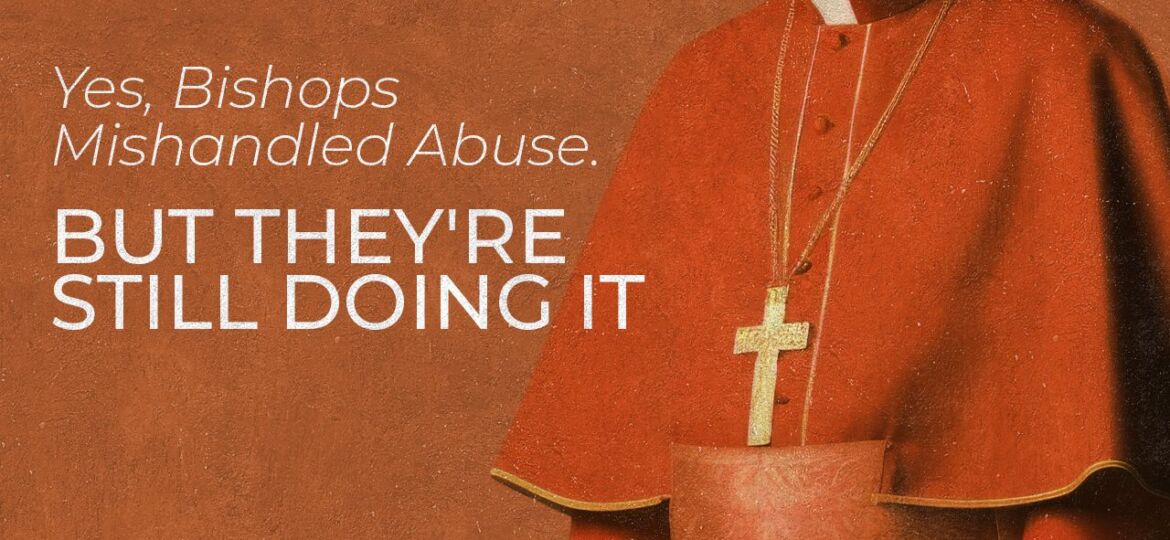Two new stories show little has changed in the Catholic hierarchy
Two dioceses. Different bishops. Different states. Different laws.
Yet, the same disturbing yet familiar and irresponsible pattern: secrecy and recklessness about child molesting Catholic clerics ends only when it’s publicly exposed by someone outside the institution.
First, let’s look first at the Diocese of Cleveland, then the Diocese of Kalamazoo. We want to stress, right up front, that the deception revealed here is recent.
We’re not talking about bad, selfish or poorly informed decisions from the 1960s or 1970s… We’re talking about behavior that happened mere months ago.
CLEVELAND
Keith Kozak
He’s a convicted sex offender.
He’s on the sex offender registry.
He must stay on the registry for 25 years.
He was, in fact, arrested recently, in 2020.
He spent nearly a year in prison.
According to Kozak, he and his pastor had “a nice, long talk” about all this.
Yet the pastor let him “help lead masses for months.”
And in fact, a video shows that in April, he was part of a mass led by Bishop Edward Malesic, the head of the Cleveland Diocese.
Yes, you read correctly: this man, Keith Kozak, a registered sex offender, was allowed to help lead Catholic masses. For months, he’s been on the altar of a parish – once with Cleveland’s top Catholic official – and he remained there until a local television station’s investigation revealed his role as a cantor for St. Thomas More parish in the Cleveland suburb of Brooklyn.
What’s wrong with this? That’s an easy question. Practically everything.
A tougher question might be: Where to start?
Let’s begin with the pastor.
According to a news account, “The diocese knew Kozak prior to his sex offender conviction.”
Kozak himself says “I sat down with (Fr. Michael Feldtz, his pastor) and we had a nice long talk, plus I filed paperwork with the diocese.” So, a pastor – and other church staff at the diocesan headquarters – apparently knew that week after week, a convicted sex offender had a title and a role and was repeatedly put up on the altar during masses.
And when his irresponsible – indeed, inexcusable – conduct was revealed by a journalist, did Fr. Feldtz even apologize?
Apparently not.
How about Fr. Feldtz’s boss, Bishop Edward Malesic? How did he act when this all came to light? First, he doesn’t deny knowing about Kozak’s criminal conviction. Then, he refused to talk with the news media or the parish about this situation. Next, he announces that Fr. Feldtz will resign, yet claims Fr. Feldtz was granted ‘sick leave’ which ‘allows a priest to focus on health issues.’
Even more disturbing, he refused to answer such questions as “Did he or any church officials tell the flock at St. Thomas More about Kozak’s criminal past?” And – more importantly – “Are there any other sex offenders working in the diocese as paid employees or volunteers?” Finally, did Bishop Malesic apologize to parishioners about all of this recklessness and secrecy was brought to light?
Apparently not.
KALAMAZOO
When it comes to clergy sex crimes and cover-ups, perhaps no Attorney General in the United States has been as aggressive, nor as successful, as Michigan’s Dana Nessel.
Other Attorney Generals – like Josh Shapiro of Pennsylvania and Kwame Raoul of Illinois – have produced impressive and lengthy reports detailing crimes by clerics and collusion by church officials. But neither have been as successful as Nessel when it comes to charging and convicting predator priests.
Recently, Nessel released the third of seven reports stemming from a years-long investigation into clergy sexual abuse and cover-ups in Michigan’s Catholic dioceses.
Unlike his colleague in Cleveland, however, Kalamazoo Bishop Edward Lohse has a shrewder public relations strategy: He decided to try and ‘get out in front’ of AG Nessel’s disclosure.
Knowing that the Attorney General’s report would soon be unveiled – and hoping to take the wind out of Nessel and that report – Bishop Lohse took a more proactive approach. In April, he released a list of individuals barred from working with children within the Diocese because of abuse or inappropriate conduct around kids and vulnerable adults.
On one hand, one could argue that any disclosure about clerics who commit or conceal child sex crimes is good. One could also argue that including the names of both clergy and non-clergy offenders is good, as is noting whether each person is living or deceased.
But take a step back and look at these three broader, unanswered questions:
- How long has Bishop Lohse, and his predecessors and underlings, risked kids’ safety by staying silent about these potentially dangerous men and why does it take the threat of an impending – and likely scathing – report from Michigan’s Attorney General to see action?
- Will the bishop and other church staff follow through and keep these potentially dangerous people out of parish roles and responsibilities, both paid and volunteer?
The takeaways from these two disturbing incidents in two different dioceses are clear but disappointing.
- First, it seems that Catholic bishops still disclose information about proven, admitted, and credibly accused child molesting clerics ONLY in response to external pressure.
- Second, it seems that Catholic bishops still give only a slap on the wrist to church employees who hire or hide predators, and only when they’re forced to act because of external pressure.


